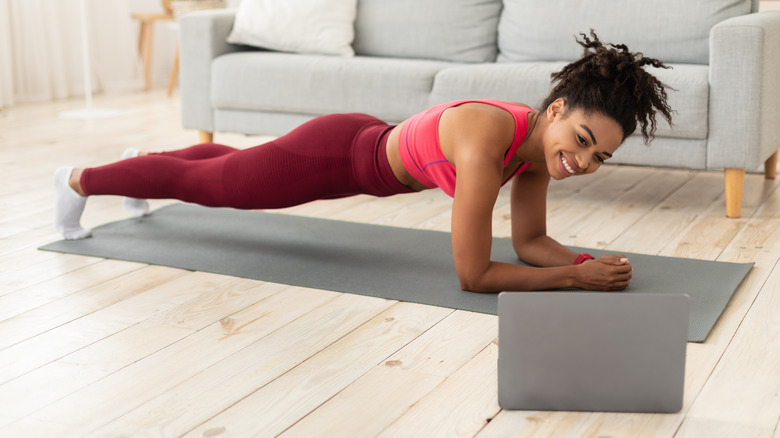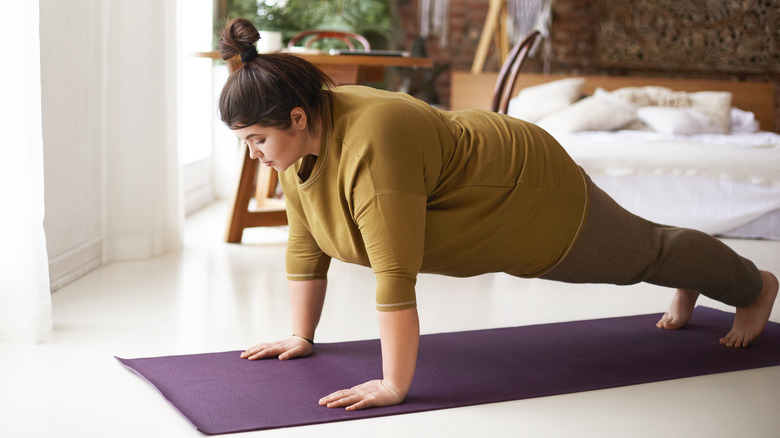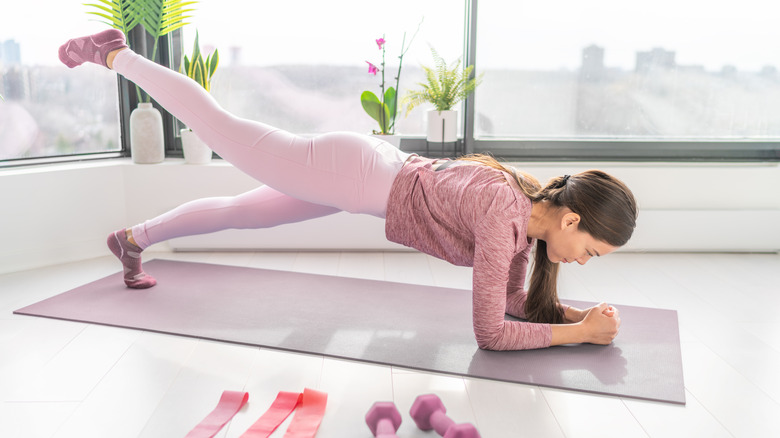How Long Do You Really Need To Hold A Plank For?
If you ever wish a moment could last forever, try dropping to the floor and holding a plank — or any isometric exercise for that matter. As opposed to isotonic exercises like squats, which lengthen and contract the muscles, isometric exercises work muscle fibers by holding the joints still (via the Mayo Clinic). Some other examples of isometric exercises include wall sits, warriors, and V-sits. During isometric exercises, the goal is to maintain the pose for a certain amount of time without falling or shifting.
A plank is an isometric exercise in which a person holds their body away from the ground on their arms and toes. This pose mainly works the abdominal muscles, helping to build and maintain core strength. Many people find planks to be extremely difficult, especially when they're asked to hold them for a minute or more. Of course, there are a few prodigies. For instance, Dana Glowacka holds the latest record for the longest plank position held by a female, with four hours, 19 minutes, and 55 seconds (via Women's Health). For most people, the mere idea of holding this pose for four hours is enough to feel sore, but are there any benefits to holding it for long periods of time? Here's what you need to know about the ideal plank duration.
How to do a perfect plank
There is no steadfast rule for how long you should hold a plank pose. For some people, 10 seconds will be challenging enough, while others may not feel the burn for 60 seconds or more. Coach M. Morris explains that anywhere between three and 10 seconds can be an effective duration for isometric muscle tension. If you're new to ab exercises, it may be helpful to work in short bursts. Try holding your plank for five to ten seconds, then resting for five to 10 seconds and repeating. Holding the position as long as possible (sometimes called holding "until failure") is great for strength training, but it won't benefit you much if you aren't using the proper form.
Proper form is crucial for any isometric exercise, especially where your core and back muscles are involved. According to fitness instructor Cathe Friedrich, the most common mistake people make with their planks is arching their back and allowing their hips to sag. This puts all of the strain on your lower back and disengages your anterior abdominal muscles. Try to plant your elbows directly below your shoulders, and focus on keeping your hips square with your ankles. Keep your neck and shoulders in a neutral position and push the earth away from your body. Most importantly, remember to breathe!
Plank your way
Planks are an easily adaptable exercise. If you're having trouble holding the pose for more than a few seconds, try some variations. Straightening your arms will put more tension on your wrists and shoulders, while dropping your knees can relieve some pressure from your abs. Cathe explains that a plank pose works more than just your abs, so be sure you're engaging supporting muscles like your upper back, glutes, and quads. According to Livestrong, adding exercises like supermans and hollow body holds will also improve your overall strength and make planks easier.
If you're breezing through planks without feeling any burn, there are some moves you can do to turn up the heat. Try adding alternating leg lifts to work your glutes and test your balance. Adding hip dips will engage your obliques, while mountain climbers can help you get some cardio. Whatever you do, remember to focus on proper form and breathing. Exercising is about improving mental health just as much as physical health, so you should always move in a way that feels good to you!


